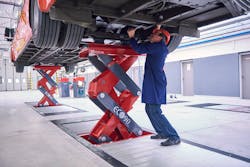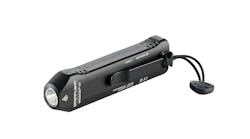In the automotive world, change is constant. Vehicles are continuously adapting to become safer, more environmentally friendly, and to meet the needs of whatever is happening in the world around them. The same can be said of the tools and equipment automotive repair shops are using to fix the vehicles, especially when it comes lift equipment and accessories. This essential shop equipment has adapted along with vehicles over the years to meet the needs of the technicians performing the repairs.
Back to the beginning
Lift equipment has been around for many years – adapting and expanding in various forms to fit the needs of the industry.
“One of the great advances was in mobile column lifts, which first entered the market in the 1980s,” says Peter Bowers, technical sales support manager for Stertil-Koni. “They were unknown technology before that time. They were all from European manufacturers. The transition of mobile columns has been from three-phase VAC cabled mobiles to battery wireless mobiles.”
Additionally, Bowers notes that mobile columns are now available with accessories to provide frame engaging lifting in the front and rear.
Looking at another type of lift system, Bowers explains that platform lifts have been around since the 1970s, but “were mostly large four-post lifts.”
“In the mid-1980s, OMER invented the hidden lifting mechanism VEGA heavy duty platform,” Bowers says. “This lift was emulated by Advantage Lifts, and that was subsequently purchased by Rotary [Lift].”
In response to that, come 2008, Stertil-Koni introduced a vertical rise platform called the SKYLIFT. Most lift manufacturers now offer a vertical rise platform lift, as it not only delivers vertical lifting, but also helps maximize floor space in the shop, Bowers notes. Many platform lifts now also include jacking beams, runway lifts, washing-bay options, and auto-pit covers as accessories.
Moving on to inground lifts, which gained popularity in the 1950s, Bowers explains that by the 1980s, these lifts were largely single stage pistons that operated on low pressure with high volumes of oil. Unfortunately, the lifts became an environmental hazard due to leaking. Later in the 80s, low volume, high pressure telescopic pistons in steel boxes became available and solved the leaking problem.
Recently, Bowers says, the big change for inground lifts has been continuous recess for telescopic piston lifts.
Advances in technology and design
In recent years, a variety of adaptions have been made to vehicle lifting equipment to stay up-to-date with the changes in vehicle design and industry demand. Features were also added to promote technician safety. The advances in lifting equipment technology and design range from something as simple as the addition of LED lighting to the more complex addition of the touchscreen control panel.
LED lighting
The addition of LED lighting on vehicle lifts is beneficial to technicians in many ways. The lights not only illuminate the technicians’ workspaces which allows them work handsfree completing their repairs and maintenance that much quicker, but also creates a safer environment where the technicians can clearly see what they are working on.
Stacey Mack, owner of Advantage Lifts, explains that the lights run down either runway on the lift, and if a shop’s lift didn’t already have the LED lights installed, the shop can easily do it themselves in minutes.
“[The lights] come with magnetic buttons that stick to the lift and are covered/enrobed during manufacturing in a clear silicone that protects the LED from shock, water, and a dropping impact,” Mack says.
Industry trends
As vehicle sizes have evolved over the years, in some cases becoming longer or heavier, vehicle lifts have also had to evolve in order to accommodate those additional inches and pounds.
Many lift equipment manufacturers, Advantage Lifts included, wound up redesigning their lifts to handle the increased width of wide body vehicles. Mack notes that Advantage addressed this by adding a full six inches to their runways.
Another change in the realm of passenger vehicles comes from a reduction in gas prices over the past few years.
“This encouraged consumers to buy larger and heavier trucks and SUVs, and even large diesel trucks,” Mack says. “Again, Advantage Lifts had to keep up, and we developed our 11,000 Series to accommodate most of even the heaviest vehicles.”
Furthermore, John Uhl, director of product management for Rotary Lift, explains how the national build-out of fiber and cellular networks, as well as the upsurge of parcel delivery vehicles due to the increase in online shopping, has created a rise in the number of medium duty trucks on the road. This again, creates the necessity of higher-capacity weight-bearing and longer vehicle lifts.
“The alignment bay has long been a strong revenue generator for dealers and shops,” Uhl says. “The best way to leverage the investment in an alignment bay is with equipment that accommodates the widest range of vehicles.”
Alignment ready
Alignment ready lifts are simply lifts that are capable of handling alignment work, Mack explains. Having a lift with this capability can save shops space and money, as the shop won’t have to buy different lifts to perform different tasks.
Mack also notes that these lifts can have a variety of features – such as slip plates, turntables, airlines, and rolling jacks – that help technicians perform their work quickly, safely, and effectively.
Touchscreen control panel
Lift manufacturer Stertil-Koni has begun adding touchscreen control panels to their vehicle lifts.
“The ebright Smart Control System puts all the necessary information on the lifting system directly at the fingertips of the service technician in the form of a computer-style tablet with a 7”, full-color touchscreen,” Stertil-Koni’s Bowers says. “This ensures the service technician can safely and efficiently get the repairs completed in the shortest time possible.”
Well-trained means safe
“Training is synonymous with safety,” Bowers says. “Any operator of a lifting system should be trained in the specific use of that system and proper location of the vehicle on the lifting system. Regular training and retraining ensure for the safest lifting environment.”
When a shop is buying a new lift, Rotary Lift’s Uhl recommends getting a demo and hands-on training from the lift distributor. This way, technicians can see how to position and operate the lift, as well as be reminded of weight limits.
If a shop is looking for more in-depth training, Uhl suggests looking online at vendors such as Rotary Lift or for training through the Automotive Lift Institute.
Advantage Lifts also offers training from senior ALI certified inspectors through Automotive Lift Services, Mack says. If they cover your area, the certified inspectors will come to your location to conduct a training session on lift safety.
Mack also warns against complacency. No matter how long someone has been a technician, training and retraining, and staying up-to-date on the new technology and advancements in lift equipment, are essential to keeping those skills sharp.


